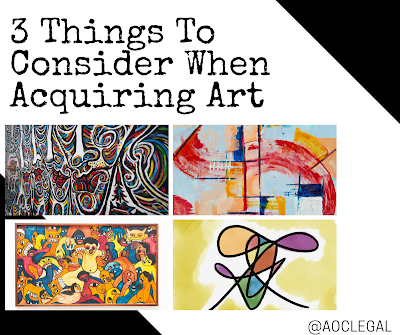
by Legalnaija | May 10, 2022 | Blawg

What is an art licensing agreement?
An artist licensing agreement allows an artist while retaining full copyright ownership of their work, to grant permission to another party to use their art.
How it works
As an artist, your job is to paint masterpieces and you must have created some amazing pieces of art in your career, which are no doubt collectors’ items. Now imagine, a brand or company wants to use your art in a promotional material, film or commercial. A licensing agreement is the legal document the artist signs with the brand or company wanting to use the art work. In this relationship, the artist is known as the Licensor, while the company or brand is known as the Licensee.
As an artist and the creator of your works of art, you are the sole owner of your work’s copyright, until you sell or transfer the copyright to another entity. Whether you become involved in an artist licensing agreement for a short amount of time, or permanently, you still own the rights to your work. As sole owner, you retain several absolute rights for the works you produce under the Copyright Act.
The Terms Covered in an Artist Licensing Agreement are
* Who the artist is and who the client is
* The duration of time that the licensing agreement will last
* The products that the artist’s images will appear on
* The distribution and the selling of the products that have the artist’s artwork on them
* The artist will have approval in how the client treats the artwork
* How much the client will agree to pay the artist in advance and in royalties
* The frequency that the client will pay the artist for the use of their work
* How the artist can exit the licensing agreement if they no longer want to be apart of it
The benefit of licensing your work can be quite substantial including more financial income.
If you are considering getting a licensing agreement for your images, you can customize and download one in less than 5 minutes to your email. Plus its cheaper, faster and easier.
Simply visit legalnaija.com to get started.
@Legalnaija
www.legalnaija.com

by Legalnaija | Jul 27, 2020 | Uncategorized
There are various reasons
why people buy art, it could be for investment, for some because they are
collectors, while for others because they are art enthusiasts and sometimes
even for emotional reasons, for instance when the buyer is drawn to what is
depicted by the artist on canvass. Some
of the most expensive paintings ever sold include Leonardo da Vinci’s Salvator
Mundi, which sold for $450.3 million at Christie’s on November 15, 2017, and Pablo
Picasso, Les Femmes d’Alger (“Version O”), which sold for $179.4 million also
at Christie’s on May 11, 2015[i].
With the price for some paintings
running into millions of naira or even dollars, one can deduce that buying art
is serious business and with such investments going into paintings, it is
important for patrons and those who seek to acquire art to note the following 3
legal points;
1.
Due
Diligence
When buying art, due diligence
should be the watch word of every patron, for instance, due diligence helps to
ensure that you are buying from the right person and that the painting is
authentic. This would include tracing the provenance as far back as one can. Due
diligence will also ensure that the documentation for the paintings are not
falsified and that the paintings are not stolen or even war artifacts. A
classic example are the Benin Bronzes, some of Africa’s greatest treasures, which
were looted decades ago.
Some paintings could also
have been stolen from museums or collectors in various parts of the world and
depending on the position of the law and facts in any legal jurisdiction in
question, a purchaser of such art may lose the title to the painting or even be
prosecuted for obtaining stolen property. Due diligence can also help determine
if the painting is fake.
2. Title
The second thing buyers of
art should consider is Title. i.e. does the seller or the seller’s principal
have the right to sell the item. A classic example is when the art work belongs
to the family but an unscrupulous member of that family goes ahead to sell the
item without the consent of other members of the family. Also, the title to the
property may be vested in some other party like a museum or the item may even
be the subject of several encumbrances. It is important to note that possession
does not necessary mean ownership. For instance, the fact that the painting is
in my possession does not necessarily make me the owner of the item.
3. Have a written contract
Executing a contract of sale
is also important when acquiring art. Having such a contract helps the buyer
secure a reasonable amount of confidence in the sale. For instance, such
contract may provide that the buyer will be indemnified in the case a 3rd
party comes with valid title to the painting or if the art is discovered to be
different from what was represented at the point of sale. Such contracts may
also include a confidentiality if parties decide that certain parts of the
agreement remain confidential e.g. the price or even their names. A contract of
sale may also help show proof of provenance upon resale by the collector.
Finally, it is important for
art buyers to use the services of professionals when acquiring art so as to
prevent any losses that may arise from a bad sale. There are however times when
a party may not have the time to carry out detailed due diligence or even have
the time to inspect the title of the seller, for instance when the buyer is an
art fair for instance. It is however important that buyer takes reasonable steps
to ensure the authenticity and title of the item.
Adedunmade
Onibokun
Adedunmade
is the Team Lead at Adedunmade Onibokun & Co. and practices in Lagos,
Nigeria. He may be reached via email on Dunmadeo@yahoo.com
[i]
Invaluable . (2019).
31 of the Most Expensive Paintings Ever Sold at
Auction. Available:
https://www.invaluable.com/blog/most-expensive-painting/. Last accessed 27th
July, 2020 .




